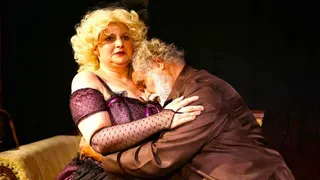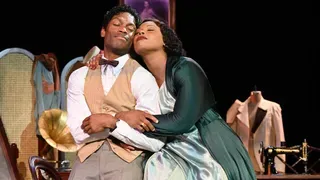March 24, 2013
The Seabirds
Michael Cox READ TIME: 5 MIN.
A completely naked man unexpectedly enters the life of Laben Shadfield, the multidimensional lighthouse keeper in William Orem 's play The Seabirds, produced by the new company Argos Productions. This man has a burly, powerful body, built through years of manual labor. But now, he is wounded, wet and shivering and his head shaven like a prisoner of war. Branded on his left hip is the letter "D."
The world of this play is the Watch Room of a lighthouse, the small area just beneath the Lantern Room. When two people occupy this claustrophobic space they become uncomfortably close. Set Designer, Matt Whiton defines the room without suffocating the actors or the audience, and even though our view is limited we are constantly aware of Maryland's Chesapeake Bay around us and the presence of the vast ocean below.
Shadfield writes in a Life Book, a journal or a log where he records the weather, the passing of ships and most importantly the activities of the seabirds. He is an avid bird watcher, and in his solitary and repetitive job seabirds are "fine companionship."
As part of Shadfield's writing ritual he speaks his words out loud, a prologue that is not delivered to the audience. He does not look out a window that faces us. Instead we look at him in profile for nearly the whole first scene as he delivers a monologue into a wall. His first action on stage is unbelievably alienating, but that is Laben Shadfield. He's not a man that is quickly embraced. (In fact, there is a quality in the way that David Lutheran plays him that is strangely disconnected. Those of us who deem ourselves experts, because of our subscriptions to Psychology Today, may diagnose him as suffering from a mild case of Asperger's syndrome. It's clear that he is very intelligent, but his sentences are not fluid, they halt erratically in fits and starts on their journey from capitol letter to period.)
It is clear that Shadfield does not often use speech to communicate with other people. This is our first indication of Shadfield's desperate loneliness, which he manages with a necessarily compulsive routine. A routine that is shattered when something catastrophic happens off stage and the naked man appears in the next scene.
Mickey Leance, the man with the branding on his naked hip, is an Irish immigrant conscripted to the Confederate army. The "D" indicates that he is a deserter, whom Shadfield decides to harbor. But for Shadfield, protecting Leance means nesting him away from danger and discovery in this watch room, and in this process, the lighthouse keeper from the North makes this deserter from the South both his prisoner and his companion.
We know that the Civil War was bloody and devastating. Men of social standing and wealth traded victories with the lives of the working class, but all of this is removed from us now. It's not something that occupies our conscience. William Orem's play changes this in our minds for two and a half hours by scaling the breadth of our nation's most overwhelming divide into an experience that is shockingly intimate. It is a parable for a nation that seems to be eternally bipartisan.
The lighthouse keeper guides travelers through the darkness and the fog with a beam of light, and he saves lives in this process. But is this passionate illumination love or merely compulsory duty? This is the set-up for a powerful and haunting play that probes the greatest forces of our lives, fate, destiny and salvation.
Big ideas have a way of falling in on an artist who works unassisted. Thanks to Brett Marks and Argos Productions, "The Seabirds" captures abstract ideologies without losing its humanity. David Lutheran and director Jeremy Johnson give us a Laben Shadfield that is at once humorous, pitiable and menacing. Brendan Mulhern has vibrant eyes and a personality that can't help but draw you in. He has a resonant and richly timbered voice, and he speaks in a thick brogue that is never suspect (thanks to the fine work of dialect consultant Nina Zendejas.) In the first scene, Shadfield talks into the walls of his self-imposed cell, but in a scene near the plays climax, Leance shatters the confines of the lighthouse and communicates almost directly with the audience. It's a powerful moment, and Mulhern performs it admirably.
There were a few moments that took me away from the time period and the magic of the narrative. Two of these were cosmetic. In a scene where Shadfield makes Leance strip off his clothing, it is very clear that Mulhern has a big, modern-looking, tattoo on the back of his neck, and the shirt that he wears through most of the play doesn't hide this either. Also, Mulhern wears his pants on his hips and not on his waist, which is technically just below the navel. You may not recognize this at first because no one wears their pants at their waist anymore, but you notice something is off. To us, it looks ridiculous to wear our pants up high, but it looks worse for a Civil War character to have a baggy inseam and a droopy seat in his pants.
The other thing that put me off just a little was in the sound design. Just after the actors had played a scene that was rich with conflicting objectives, I was left in a whimsical and wondering state. That was until the music told me I was supposed to read the scene as menacing. The final collaborator in the performance process is the audience. And just as an actor doesn't want to get a line-reading from the director, I as an audience member do not want to be overtly instructed on how to feel through didactic music in a play as richly ambiguous as this.
.
The Seabirds continue through March 30, 2013 at the Boston Playwrights�Production, 949 Commonwealth Ave, Boston, MA. For more information, visit the Argo Productions website.







